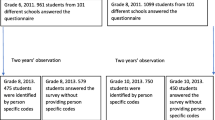Abstract
Background
Validation of body esteem measures in pre- and early adolescent male and female populations is essential as gender differences regarding weight and body size concerns often emerge during this developmental period.
Objective
The purpose of the current study was to analyze psychometric properties of the Body Esteem Scale for Adolescents and Adults (BESAA) in order to determine the utility of this instrument in a population of early adolescent males and females.
Methods
A cross-sectional survey was completed by 86 % of sixth-graders (N = 299) at a single US middle school.
Results
Confirmatory factor analysis provides support for two interpretable and interrelated subscales of the BESAA [Body esteem (BE)-weight and BE-appearance], both of which exhibit good internal consistency reliability and evidence of concurrent validity based on correlations with self-esteem and BMI. However, the following concerns about the BESAA were identified: (a) certain scale items may lack structural invariance across gender and developmental age group; (b) multiple items demonstrated a tendency to load on both factors; (c) several item pairs are similar in wording and/or meaning and show a tendency for correlated errors; and (d) an additional BE dimension assessing views about one’s muscle build and strength may be needed to fully capture body esteem among adolescent males.
Conclusions
Findings suggest cognitive interviewing and additional psychometric studies are needed for modifying the BESAA for use among early adolescents.
Similar content being viewed by others
References
Mendelson BK, Mendelson MJ, White DR (2001) Body-esteem scale for adolescents and adults. J Pers Assess 76:90–106
Franzoi SL, Shields SA (1984) The Body Esteem Scale: multidimensional structure and sex differences in a college population. J Pers Assess 48:173–178
Secord PF, Jourard SM (1953) The appraisal of body-cathexis: body-cathexis and the self. J Consult Psychol 17:343–347
Smolak L, Thompson JK (2009) Body image, eating disorders, and obesity in youth: assessment, prevention, and treatment, 2nd edn. American Psychological Association, Washington, DC
McCabe MP, Ricciardelli LA (2005) A longitudinal study of body image and strategies to lose weight and increase muscles among children. J Appl Dev Psychol 26:559–577
Wertheim EH, Paxton SJ, Blaney S (2009) Body Image in Girls. In: Smolak L, Thompson JK (eds) Body image, eating disorders, and obesity in youth: assessment, prevention, and treatment, 2nd edn. American Psychological Association, Washington, DC, pp 47–76
Ricciardelli L, McCabe M, Mussap A, Holt K (2009) Body image in preadolescent boys. In: Smolak L, Thompson JK (eds) Body image, eating disorders, and obesity in youth: assessment, prevention, and treatment, 2nd edn. American Psychological Association, Washington, DC, pp 77–96
Sands R, Tricker J, Sherman C et al (1997) Disordered eating patterns, body image, self-esteem, and physical activity in preadolescent school children. Int J Eat Disord 21:159–166
Allon N (1979) Self-perceptions of the stigma of overweight in relationship to weight-losing patterns. Am J Clin Nutr 32:470–480
Franzoi SL (1994) Further evidence of the reliability and validity of the Body Esteem Scale. J Clin Psychol 50:237–239
Franzoi SL, Herzog ME (1986) The Body Esteem Scale: a convergent and discriminant validity study. J Per Assess 50:24–31
Mendelson BK, White DR (1982) Relation between body-esteem and self-esteem of obese and normal children. Percept Mot Skills 54:899–905
Mendelson BK, White DR, Mendelson MJ (1996) Self-esteem and body esteem: effects of gender, age, and weight. J Appl Dev Psychol 17:321–346
Kaczmarski JM, DeBate RD, Marhefka SL et al (2011) State-mandated school-based BMI screening and parent notification: a descriptive case study. Health Promot Pract 12:797–801
Blumer H (1986) Symbolic interactionism: perspective and method. University of California Press, Berkley
Rosenberg M (1965) Society and the adolescent self-image. Princeton University Press, Princeton
Blascovich J, Tomaka J (1993) Measures of self-esteem. In: Robinson JP, Shaver PR, Wrightsman LS (eds) Measures of personality and social psychological attitudes, 3rd edn. Institute for Social Research, Ann Arbor, pp 115–160
Floyd FJ, Widaman KF (1995) Factor analysis in the development and refinement of clinical assessment instruments. Psychol Assess 7:286–299
Hu L, Bentler P (1999) Cutoff criteria for fit indexes in covariance structure analysis: conventional criteria versus new alternatives. Struct Equ Model 6:1–55
Browne MW, Cudeck R (1992) Alternative ways of assessing model fit. Sociol Method Res 21:230–258
Schreiber JB, Nora A, Stage FK, Barlow EA, King J (2006) Reporting structural equation modeling and confirmatory factor analysis results: a review. J Educ Res 99:323–337
Gerbing DW, Anderson JC (1984) On the meaning of within-factor correlated measurement errors. J Consum Res 11:572–580
MacCallum RC, Widaman KF, Preacher KJ et al (2001) Sample size in factor analysis: the role of model error. Multivar Behav Res 36:611–637
Acknowledgments
The first author would like to thank Robert Dedrick for the guidance and recommendations he provided on earlier drafts of this manuscript.
Conflict of interest
The authors declare that they have no conflict of interest.
Author information
Authors and Affiliations
Corresponding author
Rights and permissions
About this article
Cite this article
Cragun, D., DeBate, R.D., Ata, R.N. et al. Psychometric properties of the Body Esteem Scale for Adolescents and Adults in an early adolescent sample. Eat Weight Disord 18, 275–282 (2013). https://doi.org/10.1007/s40519-013-0031-1
Received:
Accepted:
Published:
Issue Date:
DOI: https://doi.org/10.1007/s40519-013-0031-1




